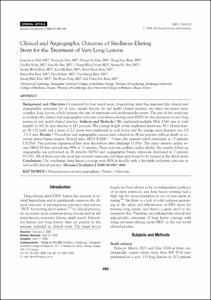KUMEL Repository
1. Journal Papers (연구논문)
1. School of Medicine (의과대학)
Dept. of Internal Medicine (내과학)
Clinical and Angiographic Outcome of Sirolimus-Eluting Stent for the Treatments of Very Long Lesions
- Keimyung Author(s)
- Nam, Chang Wook; Hur, Seung Ho; Han, Seong Wook; Kim, Kee Sik; Kim, Yoon Nyun; Kim, Kwon Bae
- Department
- Dept. of Internal Medicine (내과학)
- Journal Title
- Korean Circulation Journal
- Issued Date
- 2006
- Volume
- 36
- Issue
- 7
- Keyword
- Percutaneous coronary angioplasty; Stents; Outcome
- Abstract
- Background and Objectives : Compared to bare metal stent, drug-eluting stent has improved the clinical and angiographic outcomes for de novo, simple lesions. In real world clinical practice, we often encounter more complex, long lesions, which increase the rate of restenosis and cardiovascular events. The aim of this study was to evaluate the clinical and angiographic outcome of sirolimus-eluting stent (SES) for the treatment of very long lesions in real world clinical practice. Subjects and Methods : We implanted multiple SESs (>40 mm in total length) in 113 de novo lesions in 113 patients. The average length of the implanted stents was 58±14 mm (range: 41-112 mm) and a mean of 2.2 stents were implanted in each lesion and the average stent diameter was 3.0±0.3 mm. Results : Procedural and angiographic success were achieved in all the patients without death or coronary artery bypass surgery. Non-Q wave MI (CK-MB ≥ 3 times the normal value) developed in 13 patients (11.5%). Two patients experienced late stent thrombosis after discharge (1.8%). The major adverse cardiac events (MACE)-free survival was 94% at 12 months. There were two sudden cardiac deaths. Six months follow up angiography was performed on 76 patients (67%) and angiographic binary restenosis developed in 7 patients (9.2%). All of them were the focal type in-stent restenosis and these were found to be located at the distal stents. Conclusion : In conclusion, long lesion coverage with SESs is feasible with a favorable mid-term outcome in real world clinical practice.
- Publisher
- School of Medicine
- Citation
- Jong-Seon Park et al. (2006). Clinical and Angiographic Outcome of Sirolimus-Eluting Stent for the Treatments of Very Long Lesions. Korean Circulation Journal, 36(7), 490–494. doi: 10.4070/kcj.2006.36.7.490
- Type
- Article
- ISSN
- 1738-5520
- Appears in Collections:
- 1. School of Medicine (의과대학) > Dept. of Internal Medicine (내과학)
- 파일 목록
-
-
Download
 oak-aaa-03280.pdf
기타 데이터 / 418.71 kB / Adobe PDF
oak-aaa-03280.pdf
기타 데이터 / 418.71 kB / Adobe PDF
-
Items in Repository are protected by copyright, with all rights reserved, unless otherwise indicated.